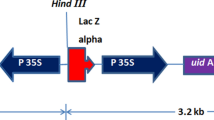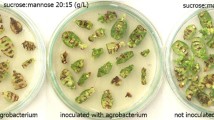Abstract
Potato is one of the main targets for genetic improvement by gene transfer. The aim of the present study was to establish a robust protocol for the genetic transformation of three dihaploid and four economically important cultivars of potato using Agrobacterium tumefaciens carrying the in vivo screenable reporter gene for green fluorescent protein (gfp) and the marker gene for neomycin phosphotransferase (nptII). Stem and leaf explants were used for transformation by Agrobacterium tumefaciens strain LBA4404 carrying the binary vector pHB2892. Kanamycin selection, visual screening of GFP by epifluorescent microscopy, PCR amplification of nptII and gfp genes, as well as RT-PCR and Southern blotting of gfp and Northern blotting of nptII, were used for transgenic plant selection, identification and analysis. Genetic transformation was optimized for the best performing genotypes with a mean number of shoots expressing gfp per explant of 13 and 2 (dihaploid line 178/10 and cv. ‘Baltica’, respectively). The nptII marker and gfp reporter genes permitted selection and excellent visual screening of transgenic tissues and plants. They also revealed the effects of antibiotic selection on organogenesis and transformation frequency, and the identification of escapes and chimeras in all potato genotypes. Silencing of the gfp transgene that may represent site-specific inactivation during cell differentiation, occurred in some transgenic shoots of tetraploid cultivars and in specific chimeric clones of the dihaploid line 178/10. The regeneration of escapes could be attributed to either the protection of non-transformed cells by neighbouring transgenic cells, or the persistence of Agrobacterium cells in plant tissues after co-cultivation.












Similar content being viewed by others
Abbreviations
- GA:
-
Gibberellic acid
- gfp :
-
Green fluorescent protein gene
- GFP:
-
Green fluorescent protein
- gus :
-
β-Glucuronidase gene
- GUS:
-
β-Glucuronidase
- luc :
-
Luciferase gene
- MS:
-
Murashige and Skoog (1962)
- NAA:
-
Naphthaleneacetic acid
- nptII:
-
Neomycin phosphotransferase gene
- PCR:
-
Polymerase chain reaction
- RT-PCR reverse:
-
Transcriptase-polymerase chain reaction
References
Bastar MT, Luthar Z, Škof S, Bohanec B (2004) Quantitative determination of mosaic GFP gene expression in tobacco. Plant Cell Rep 22:939–944. DOI 10.1007/s00299-004-0782-2
Berthomieu P, Beclin C, Charlot F, Dore C, Jouanin L (1994) Routine transformation of rapid cycling cabbage (Brassica oleracea)—molecular evidence for the regeneration of chimeras. Plant Sci 96:223–235
Chalfie M, Tu Y, Euskirchen G, Ward WW, Prasher DC (1994) Green fluorescent protein as a marker for gene expression. Science 263:802–805. DOI10.1126/science.8303295
Christou P, McCabe DE (1992) Prediction of germ-line transformation events in chimeric R0 transgenic soybean plantlets using tissue-specific expression patterns. Plant J 2:283–290. DOI 10.1111/j.1365-313X.1992.00283.x
De Vetten N, Wolters AM, Raemakers K, Van Der Meer I, Ter Stege R, Heeres E, Heeres P, Visser R (2003) A transformation method for obtaining marker-free plants of a cross-pollinated and vegetatively propagated crop. Nat Biotechnol 21:439–442. DOI 10.1038/nbt801
Dietze J, Blau A, Willmitzer L (1995) Agrobacterium-mediated transformation of potato (Solanum tuberosum). In: Potrykus I, Spangenberg G (eds) Gene transfer to plants. Springer, Berlin Heidelberg New York, pp 24–29
Domínguez A, Cervera M, Pérez RM, Romero J, Fagoaga C, Cubero J, López MM, Juárez JA, Navaro L, Peña L (2004) Characterisation of regenerants obtained under selective conditions after Agrobacterium-mediated transformation of citrus explants reveals production of silenced and chimeric plants at unexpected high frequencies. Mol Breed 14:171–183. DOI 10.1023/B:MOLB.0000038005.73265.61
Elliott AR, Campbell JA, Dugdale B, Brettel RIS, Grof CPI (1999) Green fluorescent protein facilitates rapid in vivo detection of genetically transformed plant cells. Plant Cell Rep 18:707–714. DOI 10.1007/s002990050647
Ghorbel R, Juárez J, Navarro L, Peña L (1999) Green fluorescent protein as a screenable marker to increase the efficiency of generating transgenic woody fruit plants. Theor Appl Genet 99:350–358. DOI 10.1007/s001220051244
Halford NG (2004) Prospects for genetically modified crops. Ann Appl Biol 145:17–24. DOI 10.1111/j.1744-7348.2004.tb00355.x
Haselhof J, Siermering KR, Prasher DC, Hodge S (1997) Removal of a cryptic intron and subcellular localization of green fluorescent protein are required to mark transgenic Arabidopsis plants brightly. Proc Natl Acad Sci USA 94:2122–2127
Heeres P, Schippers-Rozenboom M, Jacobsen E, Visser RGF (2002) Transformation of a large number of potato varieties: genotype-dependent variation in efficiency and somaclonal variability. Euphytica 124:13–22. DOI 10.1023/A:1015689112703
Jefferson RA, Kavanagh TA, Bevan MW (1987) GUS fusion: β-glucuronidase as a sensitive and versatile gene fusion marker in higher plants. EMBO J 6:3901–3907
Kaeppler HF, Carlson AR, Menon GK (2001) Routine utilization of green fluorescent protein as a visual marker for cereal transformation. In vitro Cell Dev Biol–Plant 37:120–126
Köhler R (1998) GFP for in vivo imaging of subcellular structures in plant cells. Trends Plant Sci 3:317–320
Kumar A (1995) Agrobacterium-mediated transformation of potato genotypes. In: Gartland KMA, Davey MR (eds) Methods in molecular biology, vol 44. Humana Press Inc, New York Totowa, pp 121–128
Menczel L, Nagy F, Kiss ZsR, Maliga P (1981) Streptomycin resistant and sensitive somatic hybrids of Nicotiana tabacum + Nicotiana knightiana correlation of resistance to N. tabacum plastids. Theor Appl Genet 59:191–195. DOI 10.1007/BF00264975
Mercuri A, Sacchetti A, De Benedetti A, Schiva T, Alberti S (2001) Green fluorescent flowers. Plant Sci 161:961–968
Molinier J, Himber C, Hahne G (2000) Use of green fluorescent protein for detection of transformed shoots and homozygous offspring. Plant Cell Rep 19:219–223. DOI 10.1007/s002990050002
Murashige T, Skoog F (1962) A revised medium for rapid growth and bio-assays with tobacco tissue cultures. Physiol Plant 15:473–497
Olivares-Fuster O, Peña L, Duran-Vila N, Navarro L (2002) Green fluorescent protein as a visual marker in somatic hybridization. Ann Bot 89:491–497. DOI 10.1093/aob/mcf54
Ow DW, Wood KV, DeLuca M, Wet JR de, Helinski DR, Howell SH (1986) Transient and stable expression of the firefly luciferase gene in plant cell and transgenic plants. Science 234:856–859
Peña L, Pérez RM, Cervera M, Juárez JA, Navarro L (2004) Early events in Agrobacterium-mediated genetic transformation of Citrus explants. Ann Bot 94:67–74. DOI 10.1093/aob/mch117
Rakosy-Tican L, Aurori A, Aurori CM, Ispas G, Famelaer I (2004) Transformation of wild Solanum species resistant to late blight by using reporter gene gfp and msh2 genes. Plant Breed Seed Sci 50:119–128
Rommens CM, Humara JM, Ye J, Yan H, Richael C, Zhang L, Perry R, Swords K (2004) Crop improvement through modification of the plant’s own genome. Plant Physiol 135:421–431. DOI 10.1104
Rizzuto R, Brini M, Pizzo P, Murgia M, Pozzan T (1995) Chimeric green fluorescent protein as a tool for vusualizing subcellular organelles in living cells. Curr Biol 5:635–642. DOI 10.1016/SO960-9822(95)00128-x
Rouwendal GJA, Mendes O, Wolbert EJH, Douwe de Boer A (1997) Enhanced expression in tobacco of the gene encoding green fluorescent protein by modification of its codon usage. Plant Mol Biol 33:989–999. DOI 10.1023/A:1005740823703
Ruiz MT, Voinnet O, Baulcombe DC (1998) Initiation and maintenance of virus-induced gene silencing. Plant Cell 10:937–946
Sidorov VA, Kasten D, Pang S-Z, Hajdukiewicz PTJ, Staub JM, Nehra NS (1999) Stable chloroplast trasnsformation in potato: use of green fluorescent protein as a plastid marker. Plant J 19:209–216. DOI 10.1046/j.1365-313X.1999.00508.x
Sheerman S, Bevan MW (1988). A rapid transformation method for Solanum tuberosum using binary Agrobacterium tumefaciens vectors. Plant Cell Rep 7:13–16. DOI 10.1007/BF00272967
Stiekema WJ, Heidekamp F, Louwerse JD, Verhoeven HA, Dijkhuis P (1988) Introduction of foreign genes into potato cultivars Bintje and Désirée using an Agrobacterium tumefaciens binary vector. Plant Cell Rep 7:47–50. DOI 10.1007/BF00272976
Zhang CL, Chen DF, McCormac AC, Scott NW, Elliot MC, Slater A (2001) Use of the GFP reporter as a vital marker for Agrobacterium-mediated transformation of suger beet (Beta vulgaris L.). Mol Biotechnol 17:109–117 (ISSN 1073-6085)
Acknowledgements
A German Academic Exchange Service (DAAD) Scholarship and a German–Romanian Bilateral Project are acknowledged for supporting part of this research (ER-T). The EU Erasmus–Socrates programme provided partial support for CD. Dr. G. Hahne and Dr. J. Molinier kindly provided pHB2892.
Author information
Authors and Affiliations
Corresponding author
Additional information
Communicated by L. Peña
Rights and permissions
About this article
Cite this article
Rakosy-Tican, E., Aurori, C.M., Dijkstra, C. et al. The usefulness of the gfp reporter gene for monitoring Agrobacterium-mediated transformation of potato dihaploid and tetraploid genotypes. Plant Cell Rep 26, 661–671 (2007). https://doi.org/10.1007/s00299-006-0273-8
Received:
Revised:
Accepted:
Published:
Issue Date:
DOI: https://doi.org/10.1007/s00299-006-0273-8




